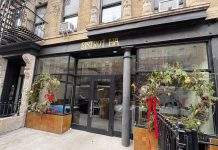
A short time ago, the Landmarks Preservation Commission voted to designate the Bialystoker Nursing Home building at 228 East Broadway. The home closed in 2011 and plans were made to redevelop the parcel. After a long campaign by local preservationists the nursing home board dropped its opposition to landmarking. The building is expected to be sold and converted to condominiums. More to come…
UPDATE 4:24 p.m. The vote was unanimous. Several commissioners spoke in glowing terms about the worthiness of the building, which is one of the last remaining physical reminders of the Jewish Lower East Side and the neighborhood’s immigrant past. Commissioner Margery Perlmutter noted that the Bialystoker building stood as the Seward Park urban renewal project led to the demolition of so many other buildings in the immediate vicinity. She said this is part of what makes the structure special but also referenced its “quite extraordinary (Art Deco) architecture.” Another commissioner said the building is especially striking because its sits at an intersection that brings together the varied architecture of several eras, including tenement construction and mid-century highrise construction. LPC Commissioner Robert Tierney said it’s a “special building” with a “special character.”
Here’s more from the commission’s press release:
Designed by the architect Harry Hurwit and opened in 1931, the nine-story Bialystoker Center and Home for the Aged building is one of the few Art Deco-style structures ever constructed on the Lower East Side. It was built by the Bialystoker Center, an umbrella organization of charitable and cultural associations formed by Jewish immigrants from Bialystok, a town located in a formerly Russian-occupied area that is now part of northeastern Poland, to assist with its recovery after World War I. From the 1880s to the 1920s, the Lower East Side was home to the largest Jewish community in the world and was the center of Jewish life and culture in the United States. The historic core of the area was at Straus Square, at the intersection of Canal and Essex streets, just west of the landmark building. In the 1920s, as the need for aid abroad decreased, the Bialystoker Center refocused its efforts on serving New York City’s Jewish community by constructing a nursing home with room for 250 residents, a synagogue, auditorium, sun parlors and hospital space. Prior to an urban renewal project that was completed in 1960, the building, whose rear fronted Division Street, stood in the middle of a crowded block and towered over the adjacent tenements. Hurwit, himself a Jewish immigrant from Eastern Europe, incorporated into the building a series of dramatic setbacks and chamfered corners, in what appeared to be a gesture towards the Art Deco towers under way in Midtown Manhattan. The buff and yellow brick building’s primary decorative element is a cast- stone main entrance enframement, topped by a spandrel inscribed with the word “BIALYSTOKER” written in letters similar to the Hebrew alphabet. A series of roundels depicting the symbols of the 12 tribes of Israel are and several stylized menorahs are set within the door surround. They depict a mandrake (Reuben), a city gate (Simon), a high priest’s breastplate (Levi), a lion (Judah), a camel (Issachar), a ship (Zebulun), a snake (Dan), a stag (Naphtali), tents (Gad), a tree (Asher) a bull and ox (Ephraim and Menashe) and a wolf (Benjamin). When the Bialystoker Center closed the doors of the nursing home in 2011, it was one of the last remaining and longest-running organizations of its kind in New York City. The building is currently vacant.









